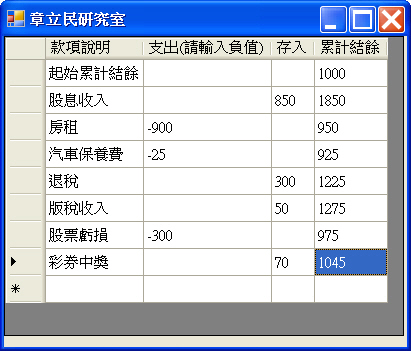使用 DataGridView 控件建立一个类似电子表格的累计结余接口
2006-12-18 10:07
543 查看

图表 1
很多人希望如图表 1 所示,利用 DataGridView 控件制作一个类似电子表格的累计结余接口。图表 1 所示之接口的程序代码如下所列,我们已经将删除数据列纳入考虑,请自行参考:
Imports System
Imports System.Drawing
Imports System.Windows.Forms
Public Class Form1
Inherits Form
Private WithEvents DataGridView1 As New DataGridView()
<STAThreadAttribute()> _
Public Shared Sub Main()
Application.Run(New Form1())
End Sub
Private Sub Form3_Load(ByVal sender As System.Object, ByVal e As System.EventArgs) Handles MyBase.Load
With Me
.AutoSize = True
.Controls.Add(DataGridView1)
.PopulateDataGridView()
.UpdateBalance()
End With
End Sub
Private Sub PopulateDataGridView()
With Me.DataGridView1
.Size = New Size(400, 300)
.AllowUserToDeleteRows = True
.ColumnCount = 4
.SelectionMode = DataGridViewSelectionMode.RowHeaderSelect
.Columns(0).Name = "款项说明"
.Columns(1).Name = "支出"
.Columns(2).Name = "存入"
.Columns(3).Name = "累计结余"
.Columns("款项说明").HeaderText = "款项说明"
.Columns("支出").HeaderText = "支出(请输入负值)"
.Columns("存入").HeaderText = "存入"
.Columns("累计结余").HeaderText = "累计结余"
.Columns("累计结余").ReadOnly = True
.Columns("款项说明").SortMode = _
DataGridViewColumnSortMode.NotSortable
.Columns("支出").SortMode = _
DataGridViewColumnSortMode.NotSortable
.Columns("存入").SortMode = _
DataGridViewColumnSortMode.NotSortable
.Columns("累计结余").SortMode = _
DataGridViewColumnSortMode.NotSortable
End With
With Me.DataGridView1.Rows
.Add(New String() {"起始累计结余", "", "", "1000"})
.Add(New String() {"股息收入", "", "850", ""})
.Add(New String() {"房租", "-500", "", ""})
.Add(New String() {"汽车保养费", "-25", "", ""})
.Add(New String() {"退税", "", "300", ""})
End With
' 允许用户编辑起始累计结余储存格
DataGridView1.Rows(0).ReadOnly = True
DataGridView1.Rows(0).Cells("累计结余").ReadOnly = False
' 自动调整数据行大小
Me.DataGridView1.AutoResizeColumns()
End Sub
Private Sub CellValueChanged(ByVal sender As Object, _
ByVal e As DataGridViewCellEventArgs) _
Handles DataGridView1.CellValueChanged
' 每当有任何储存格的值变更时就更新累计结余数据行
UpdateBalance()
End Sub
Private Sub RowsRemoved(ByVal sender As Object, _
ByVal e As DataGridViewRowsRemovedEventArgs) _
Handles DataGridView1.RowsRemoved
' 每当有任何数据列被删除时就更新累计结余数据行
UpdateBalance()
End Sub
Private Sub UpdateBalance()
Dim counter As Integer
Dim balance As Integer
Dim deposit As Integer
Dim withdrawal As Integer
' 循环处理起始累计结余数据列以外的每一列
For counter = 1 To (DataGridView1.Rows.Count - 2)
deposit = 0
withdrawal = 0
balance = Integer.Parse(DataGridView1.Rows(counter - 1) _
.Cells("累计结余").Value.ToString())
If Not DataGridView1.Rows(counter) _
.Cells("存入").Value Is Nothing Then
' 确认储存格值不是一个空字符串
If Not DataGridView1.Rows(counter) _
.Cells("存入").Value.ToString().Length = 0 Then
deposit = Integer.Parse(DataGridView1.Rows(counter) _
.Cells("存入").Value.ToString())
End If
End If
If Not DataGridView1.Rows(counter) _
.Cells("支出").Value Is Nothing Then
If Not DataGridView1.Rows(counter) _
.Cells("支出").Value.ToString().Length = 0 Then
withdrawal = Integer.Parse(DataGridView1.Rows(counter) _
.Cells("支出").Value.ToString())
End If
End If
DataGridView1.Rows(counter).Cells("累计结余").Value = _
(balance + deposit + withdrawal).ToString()
Next
End Sub
Private Sub CellValidating(ByVal sender As Object, _
ByVal e As DataGridViewCellValidatingEventArgs) _
Handles DataGridView1.CellValidating
Dim testInteger As Integer
If Not e.ColumnIndex = 0 Then
If Not e.FormattedValue.ToString().Length = 0 Then
' 尝试将储存格值转换成一个整数
If Not Integer.TryParse(e.FormattedValue.ToString(), _
testInteger) Then
DataGridView1.Rows(e.RowIndex).ErrorText = _
"错误: 无效的输入"
e.Cancel = True
End If
End If
End If
End Sub
Private Sub CellValidated(ByVal sender As Object, _
ByVal e As DataGridViewCellEventArgs) _
Handles DataGridView1.CellValidated
DataGridView1.Rows(e.RowIndex).ErrorText = Nothing
End Sub
Private Sub UserDeletingRow(ByVal sender As Object, _
ByVal e As DataGridViewRowCancelEventArgs) _
Handles DataGridView1.UserDeletingRow
Dim starting累计结余Row As DataGridViewRow = DataGridView1.Rows(0)
' 检查是否起始累计结余资料列内含于选取的数据列中
If DataGridView1.SelectedRows.Contains(starting累计结余Row) Then
If e.Row.Equals(starting累计结余Row) Then
' 不允许用户去删除起始数据列
MessageBox.Show("不可以删除累计结余列!")
End If
' 如果起始数据列被内含, 则取消删除
e.Cancel = True
End If
End Sub
End Class
相关文章推荐
- 使用 DataGridView 控件建立一个类似电子表格的累计结余接口
- 使用控件,dataGridView,如何使整个表格填满控件?
- MVC为Html对象建立一个扩展方法,使用自己的控件就像使用TextBox一样方便
- 使用两个 Windows 窗体 DataGridView 控件创建一个主/从窗体
- MVC为Html对象建立一个扩展方法,使用自己的控件就像使用TextBox一样方便
- 使用两个 Windows 窗体 DataGridView 控件创建一个主/从窗体
- DataGridView控件的使用---添加行
- [参考]一个ASP.Net的DataGrid分页控件,在Oracle数据库下,每次只取当前页的数据,不使用存储过程
- 【在线图片库】使用TreeView和DataList控件创建一个在线图片库
- 实现了IEnumerable接口的GetEnumerator 即可使用 Foreach遍历,返回一个IEnumerator对象
- DataGridView 控件使用
- DHTMLX 前端框架 建立你的一个应用程序 教程(六)-- 表格加载数据
- Ext的面向对象设计(如何建立一个继承Ext控件的"类")
- DataGridView控件 使用大全
- 最近做的一个类似Google自动完成的服务器控件
- 训练:建立和使用一个集群配置
- 使用BackgroundWorker与ProgressBar控件实现一个进度条
- 使用mfc CWnd 自绘实现一个类似于QQ好友的一个控件
- 电子表格转web程序控件SpreadsheetWeb v6.0史上最大版本发布 | 附下载
- wpf中使用控件时,最好给控件取一个好的名字
